Study on the Hot Deformation Characterization of Borated Stainless Steel by Hot Isostatic Pressing
Abstract
:1. Introduction
2. Materials and Methods
3. Results
3.1. True Stress-Strain Curves
3.2. Constitutive Analysis for BSS
3.3. Critical DRX Parameters
3.4. Metallographic Structure
4. Discussion
5. Conclusions
- The objective of this paper was to obtain data on the hot deformation characteristics and mechanisms of the Grade 304B7 by HIP: the activation energy is concluded by true σ-ε curves and calculated: Q = 442.35 kJ/mol; the constitutive equations are obtained as follows: Z = 4.570 × 1016[sinh(0.03557σp)]6.2185.
- Different perspectives were found and laid out: DRX of BSS by HIP initiates under low strain (critical strains: 0.022–0.044) and high stress (critical stresses: 146.69–254.77) with different results than that of normal stainless steels, low boron steels and cast BSS.
- Microstructure evolutions were observed differently to low boron steels and cast BSS: the hot compression boosts the generation of borides with high content boron at austenite and boron-containing phase grain boundaries.
Author Contributions
Funding
Institutional Review Board Statement
Informed Consent Statement
Data Availability Statement
Conflicts of Interest
References
- Dardel, G.V.; Sjöstrand, N.G. Absorption Cross Section of Boron for Thermal Neutrons. Phys. Rev. 1956, 96, 1566–1567. [Google Scholar] [CrossRef]
- Kim, M.J.; Kim, W.; Lee, D.; Lemaire, M.; Lee, H.J.; Sohn, D.; Kwon, H. Development of integral type spent fuel pool storage rack with gadolinium and europium-containing structure materials. Ann. Nucl. Energy 2019, 130, 107–117. [Google Scholar] [CrossRef]
- Ha, H.Y.; Jang, J.H.; Lee, T.H.; Kim, S.D.; Lee, C.H.; Moon, J. Enhancement of the resistance to localized corrosion of type 304 borated stainless steels through hot rolling. Corros. Sci. 2021, 192, 109798. [Google Scholar] [CrossRef]
- Pei, Y.; Qu, X.; Ge, Q.; Wang, T. Effect of Heat Treatment Temperature on Microstructure and Properties of PM Borated Stainless Steel Prepared by Hot Isostatic Pressing. Materials 2021, 14, 4646. [Google Scholar] [CrossRef] [PubMed]
- Petrovskiy, P.; Khomutov, M.; Cheverikin, V.; Travyanov, A.; Sova, A.; Smurov, I. Influence of hot isostatic pressing on the properties of 316L stainless steel, Al-Mg-Sc-Zr alloy, titanium and Ti6Al4V cold spray deposits. Surf. Coat. Technol. 2021, 405, 126736. [Google Scholar] [CrossRef]
- Wang, Y.; Zhang, L.; Li, X.; Yan, Z. On hot isostatic pressing sintering of fused filament fabricated 316L stainless steel—Evaluation of microstructure, porosity, and tensile properties. Mater. Lett. 2021, 296, 129854. [Google Scholar] [CrossRef]
- Tian, L.; Zheng, R.; Yuan, C.; Yang, G.; Shi, C.; Zhang, B.; Zhang, Z. Effect of grain size on the corrosion behavior of fully recrystallized ultra-fine grained 316L stainless steel fabricated by high-energy ball milling and hot isostatic pressing sintering. Mater. Charac. 2021, 174, 110995. [Google Scholar] [CrossRef]
- Hundy, B.B.; Green, A.P. A Determination of Plastic Stress-Strain Relations. J. Mech. Phys. Solids 1954, 3, 16–21. [Google Scholar] [CrossRef]
- Yun, X.; Gardner, L. Stress-strain curves for hot-rolled steels. J. Constr. Steel Res. 2017, 133, 36–46. [Google Scholar] [CrossRef]
- Bhujangrao, T.; Froustey, C.; Iriondo, E.; Veiga, F.; Darnis, P.; Mata, F.G. Review of Intermediate Strain Rate Testing Devices. Metals 2020, 10, 894. [Google Scholar] [CrossRef]
- Poliak, E.I.; Jonas, J.J. A One-Parameter Approach to Determining the Critical Conditions for the Initiation of Dynamic Recrystallization. Acta. Mater. 1996, 44, 127–136. [Google Scholar] [CrossRef]
- Zener, C.; Hollomon, J.H. Effect of Strain Rate upon Plastic Flow of Steel. J. Appl. Phys. 1944, 15, 22–32. [Google Scholar] [CrossRef]
- Poliak, E.I.; Jonas, J.J. Critical Strain for Dynamic Recrystallization in Variable Strain Rate Hot Deformation. ISIJ Int. 2003, 43, 692–700. [Google Scholar] [CrossRef]
- Zhou, Y.; Liu, Y.; Zhou, X.; Liu, C.; Yu, J.; Huang, Y.; Li, H.; Li, W. Precipitation and hot deformation behavior of austenitic heat-resistant steels: A review. J. Mater. Sci. Technol. 2017, 33, 1448–1456. [Google Scholar] [CrossRef]
- Won, C.H.; Jang, J.H.; Lee, C.H.; Lee, T.H.; Kang, N. Computational Modeling for Coarsening of (Fe,Cr) 2B in Borated Stainless Steel. Mater. Trans. 2019, 60, 369–372. [Google Scholar] [CrossRef]
- Marchattiwar, A.; Sarkar, A.; Chakravartty, J.K.; Kashyap, B.P. Dynamic Recrystallization during Hot Deformation of 304 Austenitic Stainless Steel. J. Mater. Eng. Perform. 2013, 22, 2168–2175. [Google Scholar] [CrossRef]
- Rasti, J. Grain Size Effect on the Hot Deformation Processing Map of AISI 304 Austenitic Stainless Steel. Int. J. ISSI 2018, 15, 54–61. [Google Scholar]
- Wang, X.; Wang, D.; Jin, J.; Li, J. Effects of strain rates and twins evolution on dynamic recrystallization mechanisms of austenite stainless steel. Mater. Sci. Eng. A 2019, 761, 138044. [Google Scholar] [CrossRef]
- Sharma, M.; Ortlepp, I.; Bleck, W. Boron in heat-treatable steels: A Review. Steel Res. Int. 2019, 90, 1900133. [Google Scholar] [CrossRef]
- Gao, Y.; Xue, X.; Yang, H. Influence of Boron on Initial Austenite Grain Size and Hot Deformation Behavior of Boron Microalloyed Steels. Crystals 2015, 5, 592–607. [Google Scholar] [CrossRef] [Green Version]
- Mejía, I.; López-Chipres, E.; Maldonado, C.; Bedolla-Jacuinde, A.; Cabrera, J.M. Modeling of the hot deformation behavior of boron microalloyed steels under uniaxial hot-compression conditions. Int. J. Mater. Res. 2008, 99, 1336–1345. [Google Scholar] [CrossRef]
- Chipres, E.L.; Mej’ıa, I.; Maldonado, C.; Jacuinde, A.B.; El-Wahabi, M.; Cabrera, J.M. Hot flow behavior of boron microalloyed steels. Mater. Sci. Eng. A 2008, 480, 49–55. [Google Scholar] [CrossRef]
- Banks, K.; Stumpf, W.; Tuling, A. Inconsistent flow stress in low carbon boron steels during finishing. Mater. Sci. Eng. A 2006, 421, 307–316. [Google Scholar] [CrossRef]
- Wang, X.M.; He, X.L. Effect of Boron Addition on Structure and Properties of Low Carbon Bainitic Steels. ISIJ Int. 2003, 42, S38–S46. [Google Scholar] [CrossRef]
- Mejía, I.; Jacuinde, A.B.-; Maldonado, C.; Cabrera, J.M. Determination of the critical conditions for the initiation of dynamic recrystallization in boron microalloyed steels. Mater. Sci. Eng. A 2011, 528, 4133–4140. [Google Scholar] [CrossRef]
- Cizek, P.; Parker, B.A.; Bijok, M.; Zuna, P. The Influence of Large Boride Particles on Microstructural Evolution in AISI 304 Steel. ISIJ Int. 1994, 34, 679–688. [Google Scholar] [CrossRef] [Green Version]
- Lian, X. Hot Deformation Behavior of Stainless Steel Containing Boron (Chinese). Mater. Mech. Eng. 2021, 45, 81–87. [Google Scholar]
- Zhou, X.; Wang, M.; Chen, C.; Zhao, H. Borides Effect on the Workability and Microstructure Evolution of As-Cast Borated Stainless Steel under Hot Compression. Steel Res. Int. 2016, 87, 1648–1656. [Google Scholar] [CrossRef]
- Churyumov, A.Y.; Pozdniakov, A.V.; Mondoloni, B.; Prosviryakov, A.S. Effect of boron concentration on hot deformation behavior of stainless steel. Results Phys. 2019, 13, 102340. [Google Scholar] [CrossRef]
- Bondar, A. Boron–Chromium–Iron. In Landolt-Börnstein, Group IV Physical Chemistry; Springer: Berlin/Heidelberg, Germany, 2008; pp. 403–432. [Google Scholar]
- Loria, E.A.; Isaacs, H.S. Type 304 Stainless Steel with 0.5% Boron for Storage of Spent Nuclear Fuel. JOM 1980, 32, 10–17. [Google Scholar] [CrossRef]
- Meysami, M.; Mousavi, S.A.A.A. Study on the behavior of medium carbon vanadium microalloyed steel by hot compression test. Mater. Sci. Eng. A 2011, 528, 3049–3055. [Google Scholar] [CrossRef]
- Xiao, X.; Liu, G.Q.; Hu, B.F.; Zheng, X.; Wang, L.N.; Chen, S.J.; Ullah, A. A comparative study on Arrhenius-type constitutive equations and artificial neural network model to predict high-temperature deformation behaviour in 12Cr3WV steel. Comp. Mater. Sci. 2012, 62, 227–234. [Google Scholar] [CrossRef]
- Busby, P.E.; Warga, M.E.; Wells, C. Diffusion and Solubility of Boron in Iron and Steel. Met. Trans. AIME 1953, 11, 1463–1468. [Google Scholar] [CrossRef]
- Kim, S.I.; Yoo, Y.C. Dynamic recrystallization behavior of AISI 304 stainless steel. Mater. Sci. Eng. A 2001, 311, 108–113. [Google Scholar] [CrossRef]
- Kudin, V.G.; Makara, V.A. Thermodynamic Properties of Metal–Boron Alloys. Inorg. Mater. 2002, 38, 216–219. [Google Scholar] [CrossRef]
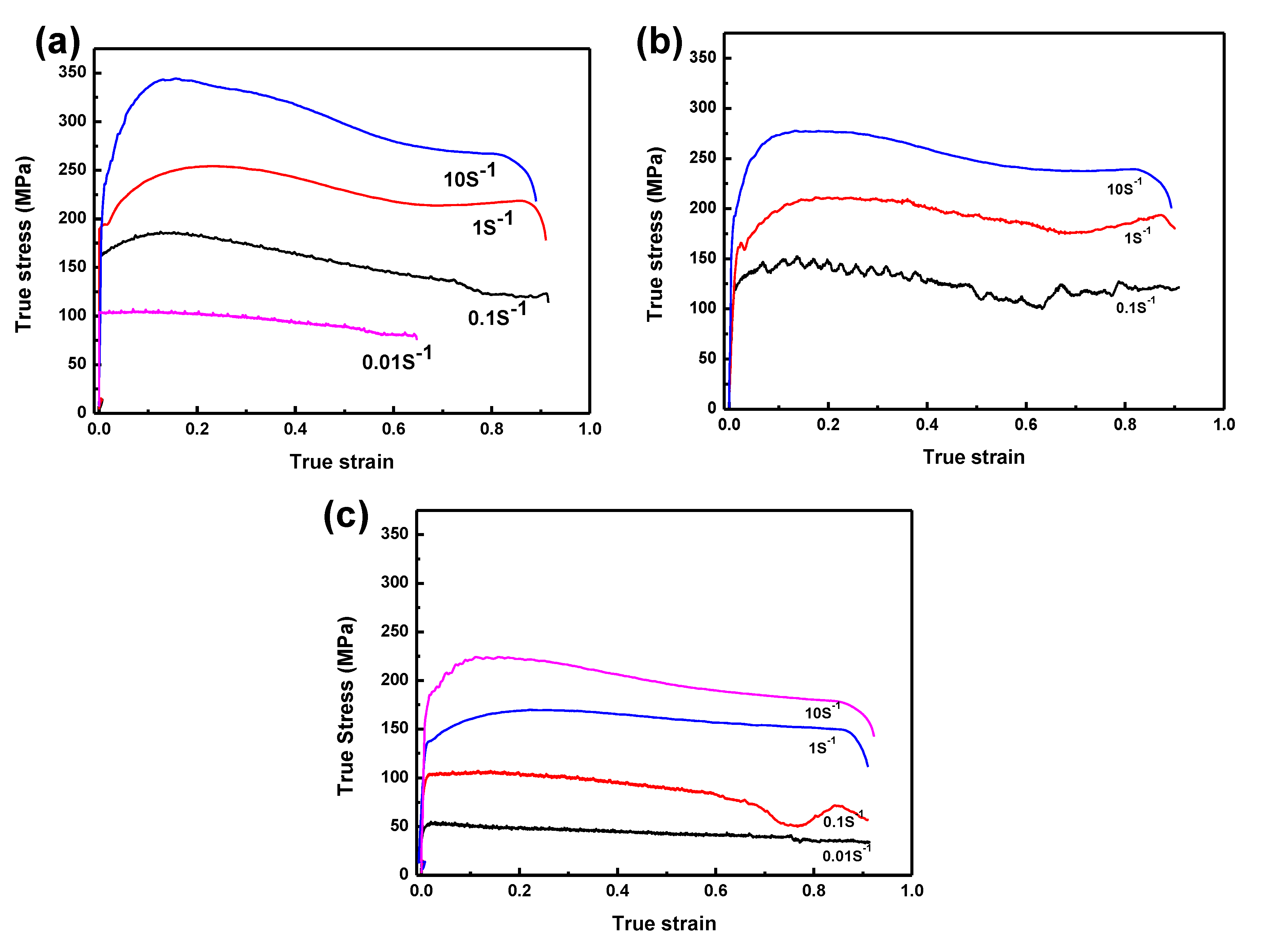

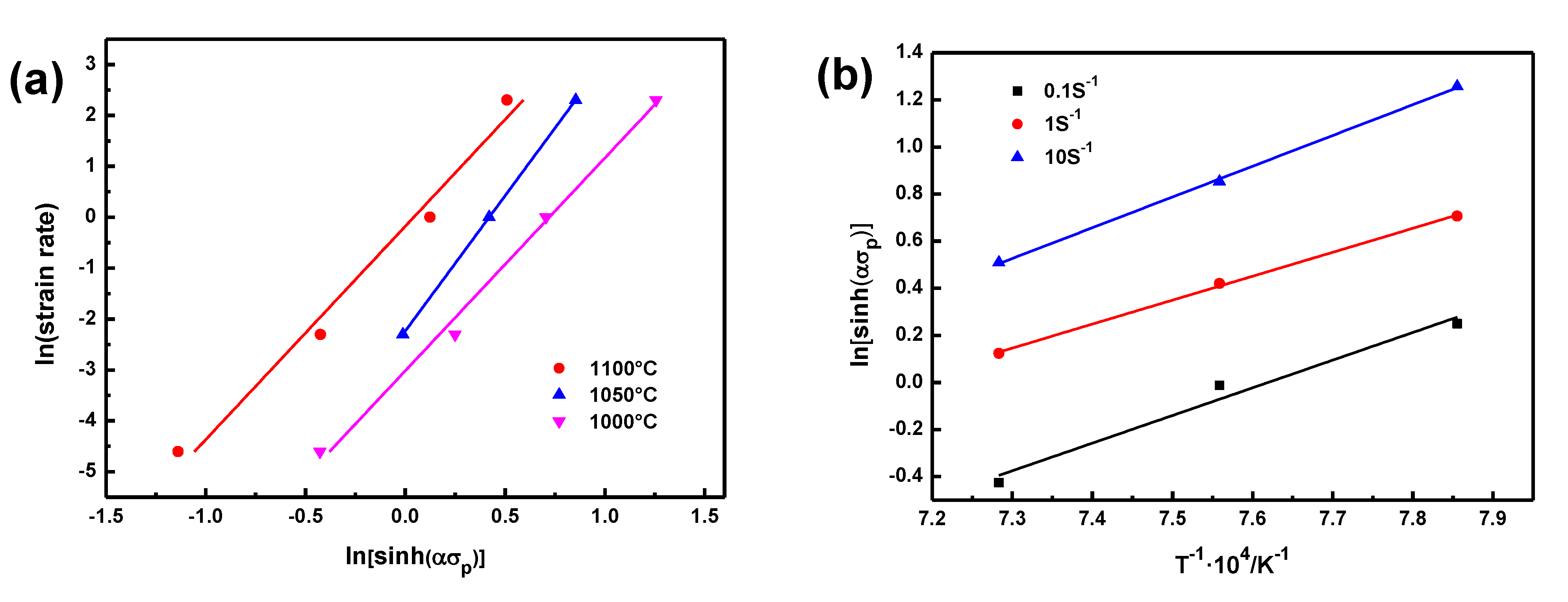

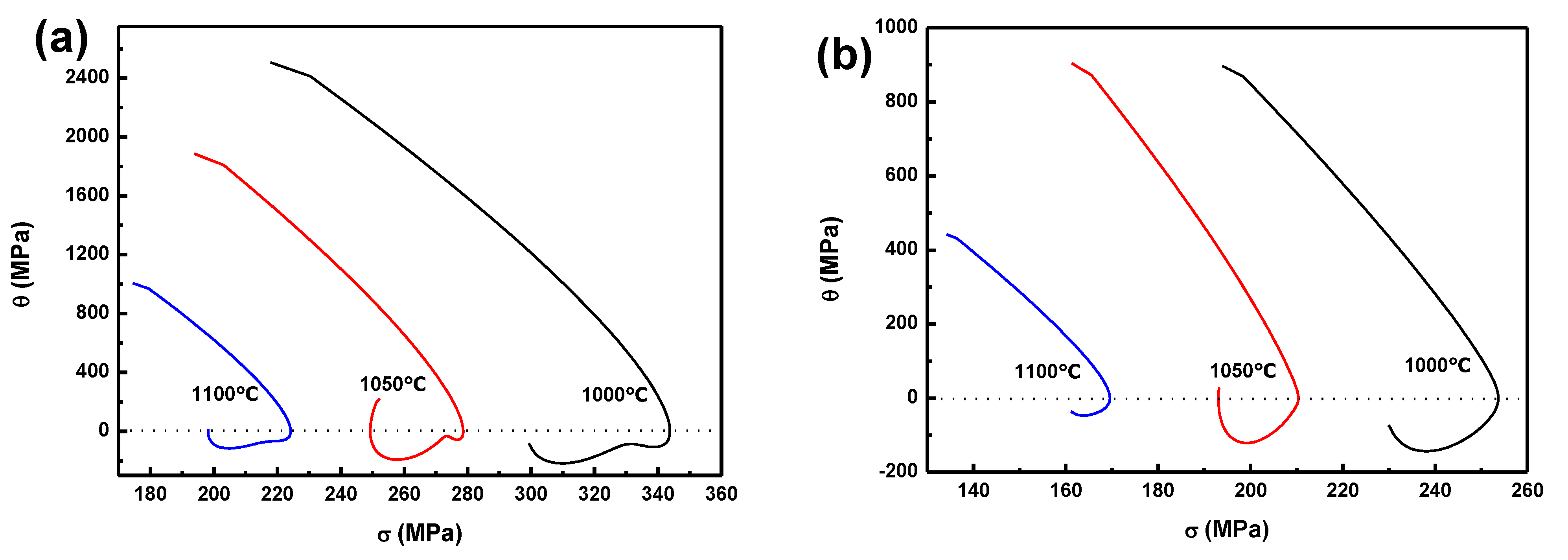
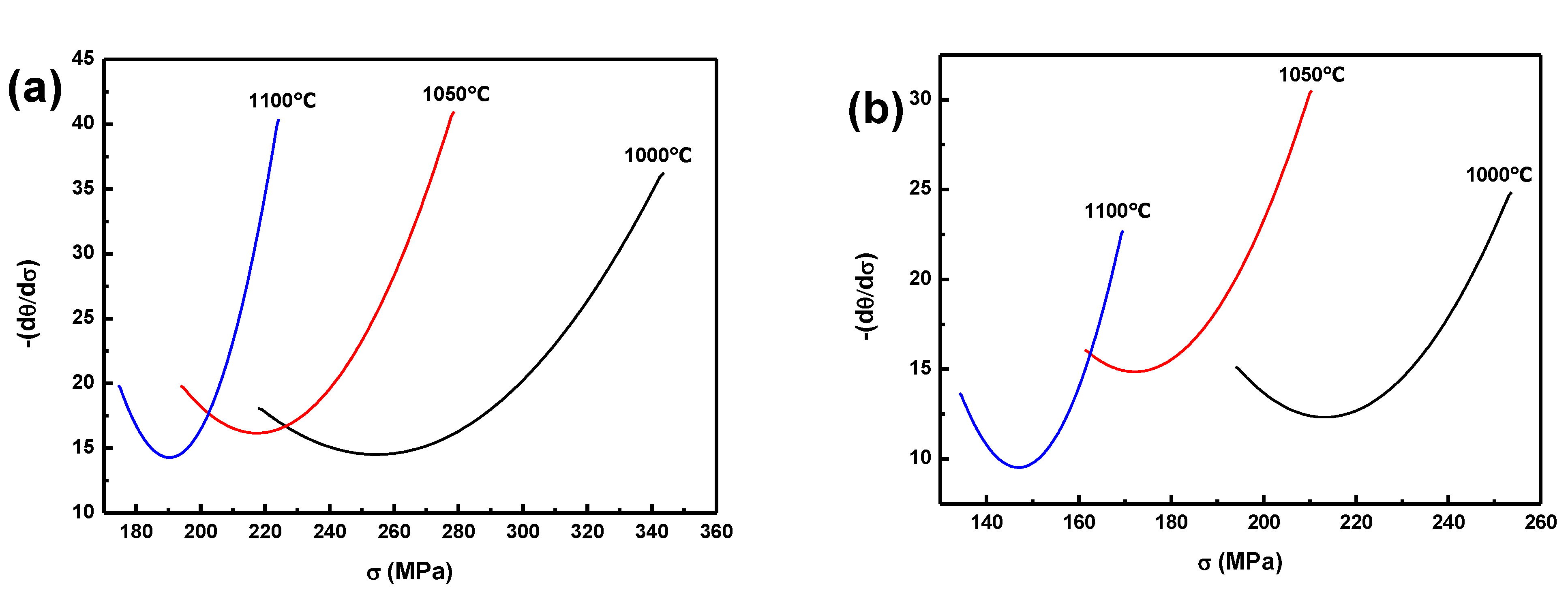
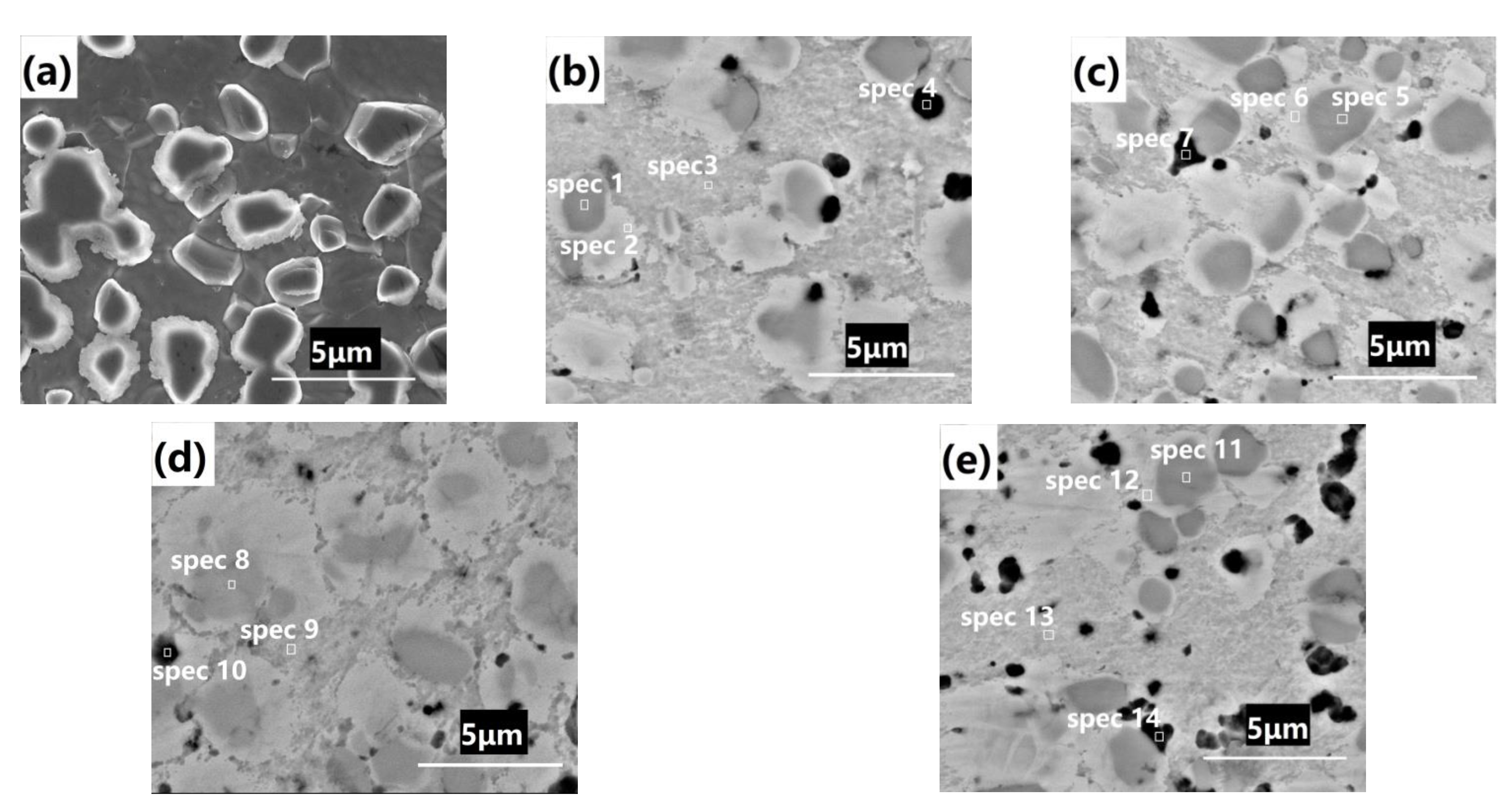
| Element | B | C | Cr | Ni | Mn | Si | P | S |
|---|---|---|---|---|---|---|---|---|
| wt% | 1.86 | 0.020 | 19.30 | 14.10 | 2.00 | 0.66 | 0.0070 | 0.0051 |
| Steel | Temperature (°C) | = 10 s−1 | = 1 s−1 | ||||
|---|---|---|---|---|---|---|---|
| σp (MPa) | σc (MPa) | σc/σp | σp (MPa) | σc (MPa) | σc/σp | ||
| 304B7 (This study), Boron content: 1.86 wt%. | 1000 | 344.36 | 254.77 | 0.74 | 254.35 | 212.65 | 0.83 |
| 1050 | 277.75 | 216.95 | 0.78 | 211.03 | 172.69 | 0.82 | |
| 1100 | 224.33 | 190.61 | 0.85 | 169.80 | 146.69 | 0.86 | |
| εp | εc | εc/εp | εp | εc | εc/εp | ||
| 1000 | 0.157 | 0.022 | 0.139 | 0.232 | 0.037 | 0.159 | |
| 1050 | 0.135 | 0.023 | 0.167 | 0.221 | 0.044 | 0.198 | |
| 1100 | 0.157 | 0.028 | 0.179 | 0.222 | 0.041 | 0.184 | |
| Steel | Temperature (°C) | σp (MPa) | σc (MPa) | σc/σp | σp (MPa) | σc (MPa) | σc/σp |
| 304B7 [27], Boron content: 1.96 wt%. | 1000 | 350 | - | - | 280 | - | - |
| 1050 | 290 | - | - | 240 | - | - | |
| 1100 | 270 | - | - | 210 | - | - | |
| Steel | Temperature (°C) | = 5 s−1 | = 0.5 s−1 | ||||
| σp (MPa) | εp | εc/εp | σp (MPa) | εp | εc/εp | ||
| AISI 304 [35] | 1000 | 192 | 0.89 | 0.73 | 133 | 0.63 | 0.73 |
| 1100 | 145 | 0.92 | 0.73 | 99 | 0.6 | 0.73 | |
| Spectrum | B | Fe | Cr | Ni | Mn | Si | |
|---|---|---|---|---|---|---|---|
| Figure 7b | 1 | - | 45.7 | 50.1 | 2.2 | 2.1 | - |
| 2 | - | 62.4 | 21.1 | 13.3 | 2.2 | 1.0 | |
| 3 | - | 66.3 | 15.0 | 15.7 | 2.1 | 0.9 | |
| 4 | 34.7 | 44.1 | 11.6 | 9.4 | - | 0.2 | |
| Figure 7c | 5 | - | 44.4 | 53.9 | 1.8 | - | - |
| 6 | - | 62.7 | 20.7 | 14.0 | 1.9 | 0.7 | |
| 7 | - | 66.6 | 14.7 | 15.7 | 2.4 | 0.6 | |
| Figure 7d | 8 | - | 45.1 | 49.5 | 2.6 | 2.8 | - |
| 9 | - | 66.3 | 14.0 | 16.2 | 2.7 | 0.8 | |
| 10 | 23.3 | 49.7 | 12.3 | 12.1 | 2.2 | 0.4 | |
| Figure 7e | 11 | - | 45.2 | 49.9 | 2.5 | 2.3 | - |
| 12 | - | 63.2 | 18.2 | 15.1 | 2.2 | 0.9 | |
| 13 | - | 66.4 | 16.4 | 14.0 | 2.3 | 0.9 | |
| 14 | - | 60.2 | 26.3 | 10.5 | 2.1 | 0.8 |
Publisher’s Note: MDPI stays neutral with regard to jurisdictional claims in published maps and institutional affiliations. |
© 2021 by the authors. Licensee MDPI, Basel, Switzerland. This article is an open access article distributed under the terms and conditions of the Creative Commons Attribution (CC BY) license (https://creativecommons.org/licenses/by/4.0/).
Share and Cite
Pei, Y.; Qu, X.; Ge, Q.; Wang, T. Study on the Hot Deformation Characterization of Borated Stainless Steel by Hot Isostatic Pressing. Materials 2021, 14, 7110. https://doi.org/10.3390/ma14237110
Pei Y, Qu X, Ge Q, Wang T. Study on the Hot Deformation Characterization of Borated Stainless Steel by Hot Isostatic Pressing. Materials. 2021; 14(23):7110. https://doi.org/10.3390/ma14237110
Chicago/Turabian StylePei, Yanbin, Xuanhui Qu, Qilu Ge, and Tiejun Wang. 2021. "Study on the Hot Deformation Characterization of Borated Stainless Steel by Hot Isostatic Pressing" Materials 14, no. 23: 7110. https://doi.org/10.3390/ma14237110







